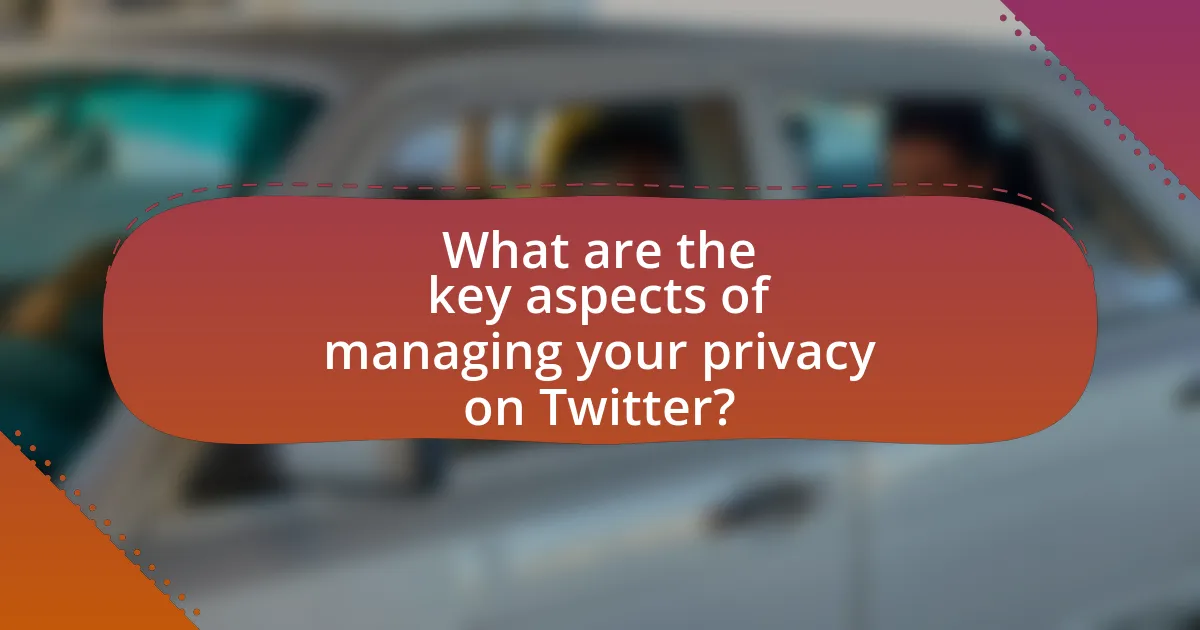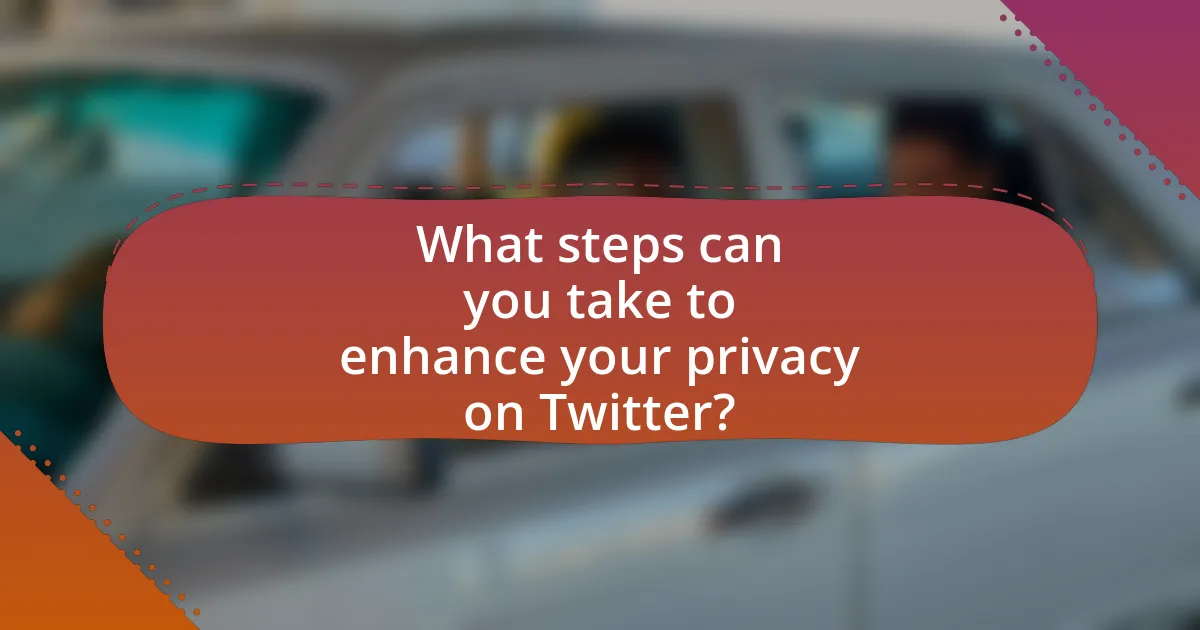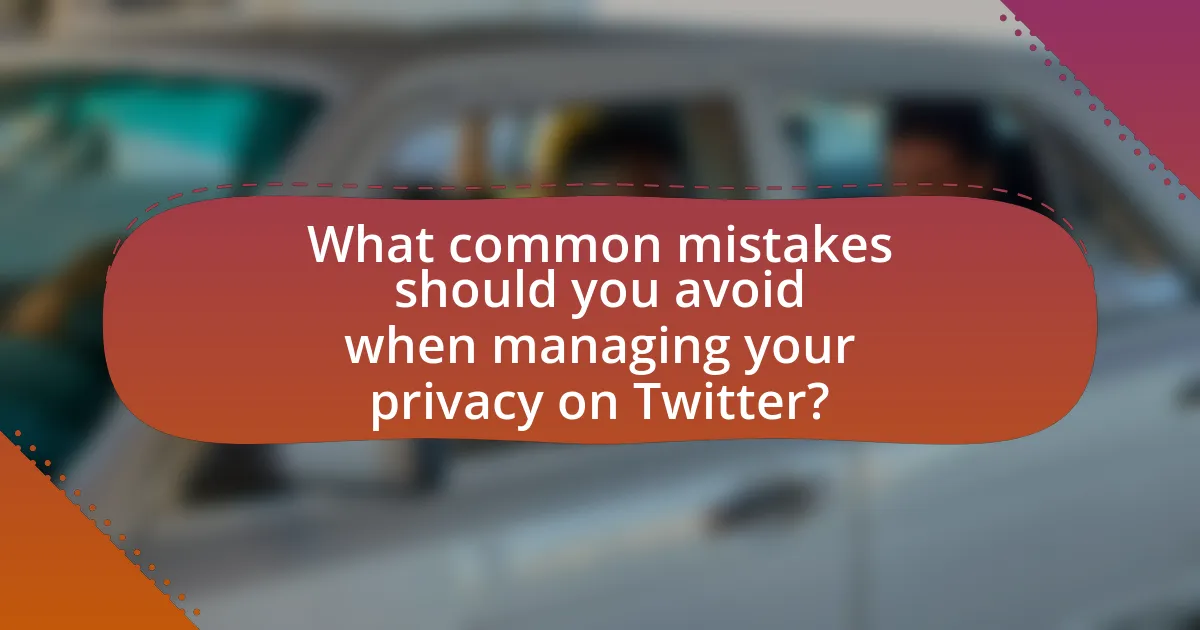The article focuses on best practices for managing privacy on Twitter, emphasizing the importance of adjusting account settings, controlling tweet visibility, and being cautious about personal information sharing. Key aspects include setting accounts to private, regularly reviewing followers, and utilizing Twitter’s privacy tools to enhance user security. The article also discusses the types of data Twitter collects, how this data is used, and the potential risks users face without proper privacy management. Additionally, it outlines steps to recognize phishing attempts and provides recommendations for maintaining privacy effectively on the platform.

What are the key aspects of managing your privacy on Twitter?
The key aspects of managing your privacy on Twitter include adjusting your account settings, controlling who can see your tweets, and being mindful of the information you share. Users should set their accounts to private to limit visibility to approved followers, which restricts public access to tweets. Additionally, users must regularly review and manage their followers, removing any that they no longer wish to have access. It is also crucial to be cautious about sharing personal information, such as location or contact details, as this can lead to privacy breaches. Twitter provides tools for reporting harassment and blocking unwanted interactions, which further enhances user privacy.
How does Twitter handle user privacy?
Twitter handles user privacy by implementing various measures to protect personal information and user data. The platform allows users to control their privacy settings, including options to make accounts private, manage who can see their tweets, and limit direct messages. Additionally, Twitter has a privacy policy that outlines how user data is collected, used, and shared, ensuring transparency. The company also complies with data protection regulations, such as the General Data Protection Regulation (GDPR) in Europe, which mandates strict guidelines for user consent and data handling.
What data does Twitter collect from users?
Twitter collects various types of data from users, including personal information, usage data, and location data. Personal information encompasses details such as names, email addresses, phone numbers, and profile pictures provided during account creation. Usage data includes information about how users interact with the platform, such as tweets, retweets, likes, and the accounts they follow. Additionally, Twitter collects location data when users enable location services, which can include precise geographic information based on their device settings. This data collection is outlined in Twitter’s privacy policy, which specifies the types of information gathered and the purposes for which it is used.
How is user data used by Twitter?
User data is used by Twitter primarily to personalize user experiences, enhance advertising effectiveness, and improve platform functionality. Twitter analyzes user interactions, such as tweets, likes, and follows, to tailor content and advertisements to individual preferences. This data-driven approach allows Twitter to deliver targeted ads, which, according to their advertising metrics, can significantly increase engagement rates. Additionally, user data helps Twitter identify trends and improve features, ensuring a more relevant and engaging platform for its users.
Why is privacy important for Twitter users?
Privacy is important for Twitter users because it protects personal information from unauthorized access and misuse. By maintaining privacy, users can control who sees their tweets, personal data, and interactions, reducing the risk of harassment, identity theft, and data exploitation. According to a 2021 Pew Research Center study, 81% of Americans feel that the potential risks of companies collecting their data outweigh the benefits, highlighting the widespread concern over privacy. This underscores the necessity for users to implement privacy settings and be aware of their digital footprint on platforms like Twitter.
What risks do users face without proper privacy management?
Users face significant risks without proper privacy management, including identity theft, data breaches, and unauthorized access to personal information. These risks arise because inadequate privacy controls can expose sensitive data, making it easier for malicious actors to exploit this information. For instance, according to a 2020 report by the Identity Theft Resource Center, there were over 1,100 data breaches in the U.S. alone, affecting millions of individuals and leading to increased instances of identity theft. Furthermore, without effective privacy settings, users may inadvertently share their location, personal preferences, and other private details, which can be misused for targeted scams or harassment.
How can privacy breaches affect users personally and professionally?
Privacy breaches can significantly impact users both personally and professionally by exposing sensitive information that can lead to identity theft, reputational damage, and loss of job opportunities. For instance, personal data such as social security numbers or financial information can be exploited by cybercriminals, resulting in financial loss and emotional distress for the affected individuals. Professionally, a breach can tarnish a user’s reputation, as employers often conduct background checks that may reveal negative information stemming from a privacy violation. According to a 2021 report by the Identity Theft Resource Center, data breaches increased by 68% compared to the previous year, highlighting the growing risk and potential consequences for users.

What steps can you take to enhance your privacy on Twitter?
To enhance your privacy on Twitter, you should adjust your account settings to limit who can see your tweets and interact with you. Start by setting your account to private, which restricts your tweets to approved followers only. Additionally, review your privacy settings to disable location tracking and prevent your tweets from being indexed by search engines. You should also manage your followers by regularly reviewing and removing any that you do not recognize or trust. Furthermore, be cautious about the personal information you share in your bio and tweets, as well as the links you click on or share. These steps collectively help protect your personal data and control your online presence on Twitter.
How can you adjust your Twitter account settings for better privacy?
To adjust your Twitter account settings for better privacy, navigate to the “Privacy and safety” section in your account settings. In this section, you can control who can see your tweets, manage your location information, and decide whether to allow others to tag you in photos. Additionally, you can enable the “Protect your Tweets” option, which restricts your tweets to only your approved followers, enhancing your privacy. Twitter also allows you to manage data sharing with third-party apps and control personalized ads, further safeguarding your information.
What specific settings should you review and modify?
You should review and modify your privacy settings, account security settings, and tweet visibility settings on Twitter. Specifically, adjust the “Protect your Tweets” option to control who can see your tweets, enable two-factor authentication for enhanced account security, and review the “Location information” setting to manage whether your location is shared with your tweets. These modifications help safeguard your personal information and enhance your overall privacy on the platform.
How can you manage your followers and who sees your tweets?
To manage your followers and control who sees your tweets, utilize Twitter’s privacy settings and follower management tools. You can set your account to private, which restricts your tweets to only those who follow you, ensuring that only approved followers can view your content. Additionally, you can manually approve or deny follow requests, allowing you to curate your audience. Twitter also provides the option to block or mute users, further controlling who interacts with your tweets. According to Twitter’s Help Center, these features empower users to maintain their privacy and manage their follower base effectively.
What tools and features does Twitter offer for privacy management?
Twitter offers several tools and features for privacy management, including account privacy settings, tweet visibility options, and data protection controls. Users can set their accounts to private, which restricts tweet visibility to approved followers only. Additionally, Twitter allows users to control who can reply to their tweets, enabling them to limit interactions. The platform also provides options to manage location sharing, block or mute accounts, and review data privacy settings, including the ability to download and delete personal data. These features collectively enhance user control over their privacy and data on the platform.
How can you use Twitter’s privacy tools effectively?
To use Twitter’s privacy tools effectively, adjust your account settings to control who can see your tweets and interact with you. Start by setting your account to private, which restricts your tweets to approved followers only. Additionally, utilize the “Protect your Tweets” option to prevent unauthorized users from viewing your content. Regularly review your followers and remove any accounts you do not recognize or trust. Furthermore, manage your location settings by disabling location tagging on tweets to enhance your privacy. Twitter also allows you to block or mute accounts that may harass you, providing a safer experience. These actions collectively help maintain your privacy and control over your Twitter presence.
What are the benefits of using third-party privacy tools alongside Twitter?
Using third-party privacy tools alongside Twitter enhances user privacy by providing additional layers of security and control over personal data. These tools can help users manage their privacy settings more effectively, block unwanted tracking, and encrypt communications, thereby reducing the risk of data breaches and unauthorized access. For instance, tools like VPNs can mask IP addresses, while browser extensions can block ads and trackers, ensuring that user activity remains private. Research indicates that users who employ such tools experience a significant decrease in targeted advertising and data collection, reinforcing the importance of integrating these solutions for improved privacy management on social media platforms like Twitter.

What common mistakes should you avoid when managing your privacy on Twitter?
Common mistakes to avoid when managing your privacy on Twitter include not adjusting your privacy settings, sharing personal information publicly, and failing to review your followers regularly. Not adjusting privacy settings can expose your tweets to a wider audience than intended; for instance, leaving your account public allows anyone to view your posts. Sharing personal information, such as your location or contact details, can lead to unwanted attention or harassment. Additionally, neglecting to review your followers can result in unknown individuals having access to your content, which can compromise your privacy. These practices are essential for maintaining a secure and private Twitter experience.
What are the pitfalls of oversharing on Twitter?
Oversharing on Twitter can lead to significant privacy risks, including identity theft, reputational damage, and unwanted attention. When users disclose personal information, such as location, contact details, or sensitive life events, they expose themselves to potential exploitation by malicious actors. A study by the Pew Research Center found that 64% of Americans have experienced online harassment, often stemming from oversharing. Additionally, oversharing can result in negative perceptions from employers or peers, as 70% of employers reportedly use social media to screen candidates. Thus, the pitfalls of oversharing on Twitter encompass both personal safety and professional consequences.
How can oversharing impact your privacy?
Oversharing can significantly compromise your privacy by exposing personal information to a wide audience, including potential threats. When users share excessive details about their lives, such as location, daily activities, or personal relationships, they create opportunities for identity theft, stalking, or harassment. A study by the Pew Research Center found that 64% of Americans have experienced some form of online harassment, often linked to oversharing on social media platforms. This data underscores the risks associated with revealing too much information, as it can lead to unwanted attention and breaches of personal security.
What types of information should you avoid sharing publicly?
You should avoid sharing personal information such as your home address, phone number, and financial details publicly. This type of sensitive information can lead to identity theft, harassment, or other security risks. Additionally, sharing your location in real-time or posting about your travel plans can make you vulnerable to burglary or stalking. According to the Federal Trade Commission, identity theft affects millions of people annually, highlighting the importance of safeguarding personal data online.
How can you recognize and avoid phishing attempts on Twitter?
To recognize and avoid phishing attempts on Twitter, users should be vigilant about suspicious messages and links. Phishing attempts often come in the form of direct messages or tweets that urge users to click on unfamiliar links or provide personal information. Users should verify the sender’s identity, look for signs of urgency or threats, and avoid clicking on links that appear unusual or are shortened URLs, as these can obscure the true destination. According to a report by the Anti-Phishing Working Group, phishing attacks have increased significantly, with over 200,000 unique phishing sites detected in a single month, highlighting the importance of being cautious.
What signs indicate a potential phishing scam?
Signs that indicate a potential phishing scam include unsolicited emails or messages that request personal information, misspellings or grammatical errors in the communication, and suspicious links that do not match the official website. Phishing attempts often create a sense of urgency, prompting users to act quickly, and may use generic greetings instead of personal names. According to the Anti-Phishing Working Group, 74% of phishing attacks are conducted via email, highlighting the prevalence of these tactics.
What steps should you take if you suspect a phishing attempt?
If you suspect a phishing attempt, immediately cease any interaction with the suspicious message or link. This includes not clicking on links, not downloading attachments, and not providing any personal information. Next, verify the sender’s identity through official channels, such as contacting the organization directly using known contact information. Report the phishing attempt to the relevant platform, such as Twitter, and consider changing your passwords for added security. According to the Anti-Phishing Working Group, phishing attacks have increased significantly, highlighting the importance of vigilance and prompt action in these situations.
What are some best practices for maintaining privacy on Twitter?
To maintain privacy on Twitter, users should adjust their account settings to protect personal information. This includes setting the account to private, which restricts visibility to approved followers only, and disabling location sharing to prevent geotagging of tweets. Additionally, users should regularly review and manage their followers, block unwanted accounts, and be cautious about sharing personal details in tweets or direct messages. Twitter’s privacy policy and security settings provide guidelines for managing data sharing and ad preferences, ensuring users have control over their information.
How can regular audits of your privacy settings improve your security?
Regular audits of your privacy settings can significantly improve your security by identifying and mitigating vulnerabilities in your account. By systematically reviewing permissions, access controls, and shared information, users can detect unauthorized access or outdated settings that may expose personal data. For instance, a study by the Ponemon Institute found that 60% of data breaches occur due to misconfigured settings, highlighting the importance of regular checks. Additionally, updating privacy settings in response to new threats or platform changes ensures that users maintain optimal security, thereby reducing the risk of identity theft and data misuse.
What proactive measures can you take to stay informed about privacy updates on Twitter?
To stay informed about privacy updates on Twitter, regularly check Twitter’s official blog and privacy policy page. Twitter frequently posts updates regarding changes to its privacy practices, which can be found at blog.twitter.com and twitter.com/privacy. Additionally, following Twitter’s official accounts on the platform, such as @TwitterSafety, provides real-time updates and alerts about privacy-related changes. Engaging with privacy advocacy organizations that monitor social media policies can also offer insights and alerts on significant updates.
